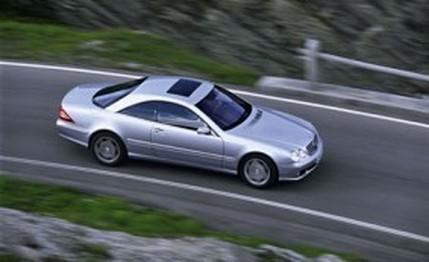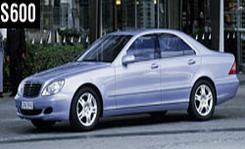
 First Drive Review
First Drive Review
If you're not old enough to remember the horsepower wars of the '50s and '60s, don't be concerned. We're currently witnessing something equally wild, as the (mostly) German automakers leapfrog each other in pushing power outputs into the stratosphere. This time, it's more a contest of torque.
The twin-turbo V-12 in the modestly face-lifted Mercedes S600 and CL600 pumps out a staggering 590 pound-feet of torque. All that muscle arrives at a mere 1800 rpm and continues unabated until 3500 rpm. Nothing, not even the Bentley Arnage's 616 pound-feet, prepares you for the impact of such phenomenal energy. There is no waiting, just an instantaneous and overwhelming thrust that elevates these Mercedes V-12s into time-warp machines. Mercedes claimed a 0-to-62-mph time of 6.3 seconds for the previous S600, and our road test (May 2001) produced a 0-to-60 sprint of 5.4 seconds. S-class or CL, the factory claims the V-12 twin-turbo does 0 to 62 in just 4.8 seconds--and in near silence, without drama, pulling ferociously all the way to a limiter at 155 mph, leaving the driver with a feeling of disbelief. Without the speed restriction, the engineers say the new S600 finally stops at 191 mph. 

Only the supercharged V-8 SL55 AMG Merc--it has 516 pound-feet from 2650 to 4500 rpm--and the soon-to-be-launched S55 AMG (powered by the same V-8) feel close to this level of power immediacy. Somehow, it seems altogether more startling in two-plus tons of refined limousine than it would in a roaring roadster or sports sedan. Mercedes developed the V-12, a thoroughly reengineered version of the now superseded naturally aspirated 5.8-liter unit, specifically for the Maybach superlimo, the marque created for people for whom an S600 isn't enough. So a slightly detuned version seemed perfectly suited to the S600 and CL600. The now 5.5-liter V-12--the bore reduced two millimeters to 82--gets two KKK turbochargers and a water-cooled intercooler to pump out 493 horsepower at 5000 rpm. Because this big-capacity unit essentially eliminates any turbo lag, many owners won't be aware that it's turbocharged. For the new 600s, the turbo boost is wound back from the Maybach's 1.2 bar to 1.0 bar, cutting 74 twisties from the Maybach's 664 pound-feet, although it's still 51 percent above the old V-12's.
Is it too much power? Not at all, since traction in both models is outstanding. A full-blooded standing start on wet roads provokes a moment of wheelspin, but it's controlled by the Electronic Stability Program (ESP), whose threshold of interference seems higher than the Mercedes norm. So much torque forced development of a stronger version of the Mercedes five-speed auto. Both shift cleanly without quite matching the seamless changes of ZF's new six-speed in the BMW 7-series and Audi's new A8 (see the preview in this issue). On the other hand, neither rival achieves the level of ride-comfort and body-control compromise generated by Mercedes' Active Body Control suspension, standard on the S600 and CL600. They remain supremely comfortable, elegant vehicles with unequaled performance.
There are no changes to either model's sheetmetal, although clear-lens headlights make both easy to pick out, at least from the front. Less obvious, on the S600, are a deeper, slightly more upright grille mounted on a hood that is 0.7 inch higher, necessary to accommodate the V-12 and achieved without changing the 0.27 coefficient of drag, and a wider, lower air intake and slight visual revisions to the front bumper. The upgrade was deemed necessary to incorporate most, but not all, of the electronic features introduced on the new E-class (the electrohydraulic brakes, for example, demand a clean-sheet change). The marketing people say 2100 parts are changed, many of them in an interior that now feels better built, more luxurious, and especially with the optional "designo" couture trim, less plasticky.
This face lift also heralds the first application of the Pre-Safe crash prediction and countermeasures system and the first all-wheel-drive version of the S-class. Mercedes says the new 4MATIC, available with 4.3- or 5.0-liter V-8 sedans but not the CL, was developed in response to the American perception that four-wheel-drive SUVs offer more driving security. It expects 80 percent of the annual production of 10,000 4MATIC S-classes to be sold in the U.S. The system borrows its basic technology from the ML- and E-class 4MATICs in using the ESP to brake any wheel (or wheels) that begins to spin, thus sending more torque to the wheels with traction. Because development began after the current model was engineered as a rear-driver, it needs a new control-arm front suspension in place of the four-link system to accommodate the driveshafts, and the steering rack is now behind the front-axle line on a new steel subframe. The system adds 230 pounds and about $3000.
Apart from the inevitable 4MATIC badge and a small intrusion into the passenger footwell to hide the driveshaft from the rear of the gearbox, it's identical to the regular S-class. And that's the way it drives, at least on dry roads, where it's virtually impossible to sense the difference between rear- and all-wheel drive.
Mercedes claims the S600 is the quickest-accelerating four-door in the world. And close to being the most comfortable. Sounds like a winning combination. Who needs the Maybach?
Specifications VEHICLE TYPE: front-engine, rear-wheel-drive, 5-passenger, 2- or 4-door sedan ESTIMATED BASE PRICE: $120,000-$124,000 ENGINE TYPES: twin-turbocharged and intercooled SOHC 36-valve 5.5-liter V-12, 493 hp, 590 lb-f TRANSMISSION: 5-speed automatic with lockup torque converter DIMENSIONS: Wheelbase: 113.6-121.5 in Length: 196.6-203.3 in Width: 73.0-73.1 in Height: 55.0-56.9 in Curb weight: 4150-4500 lb MANUFACTURER'S PERFORMANCE RATINGS: Zero to 62 mph: 4.8 sec Top speed (governor limited): 155 mph ESTIMATED FUEL ECONOMY: EPA city driving: 13 mpg EPA highway driving: 19 mpg